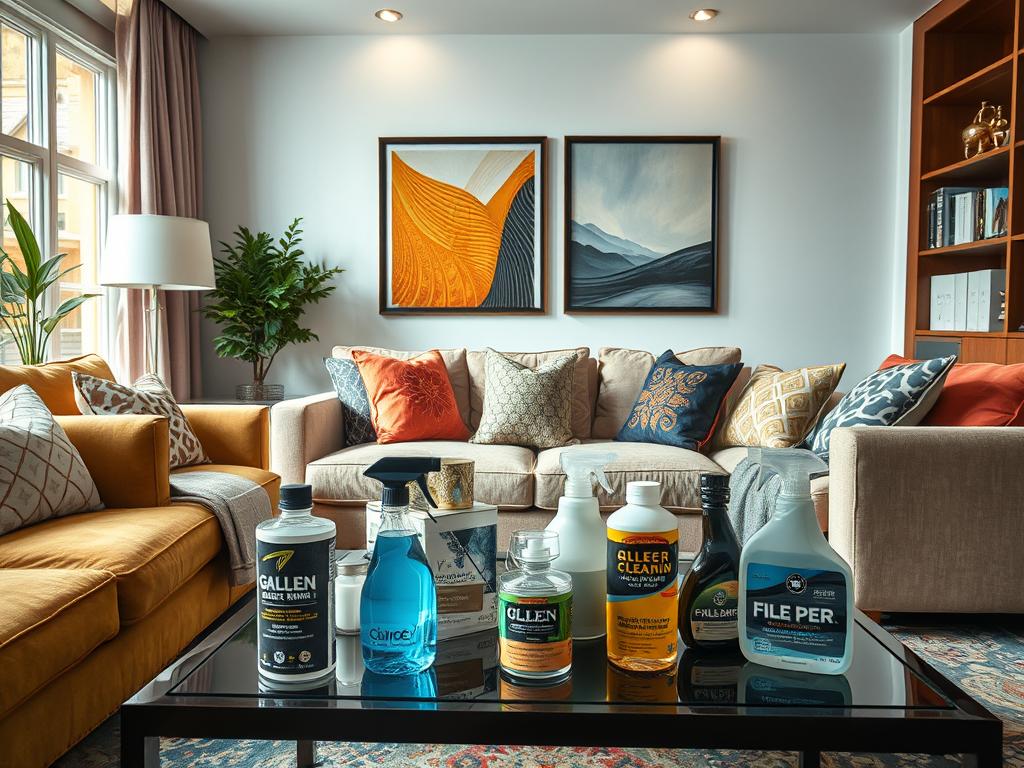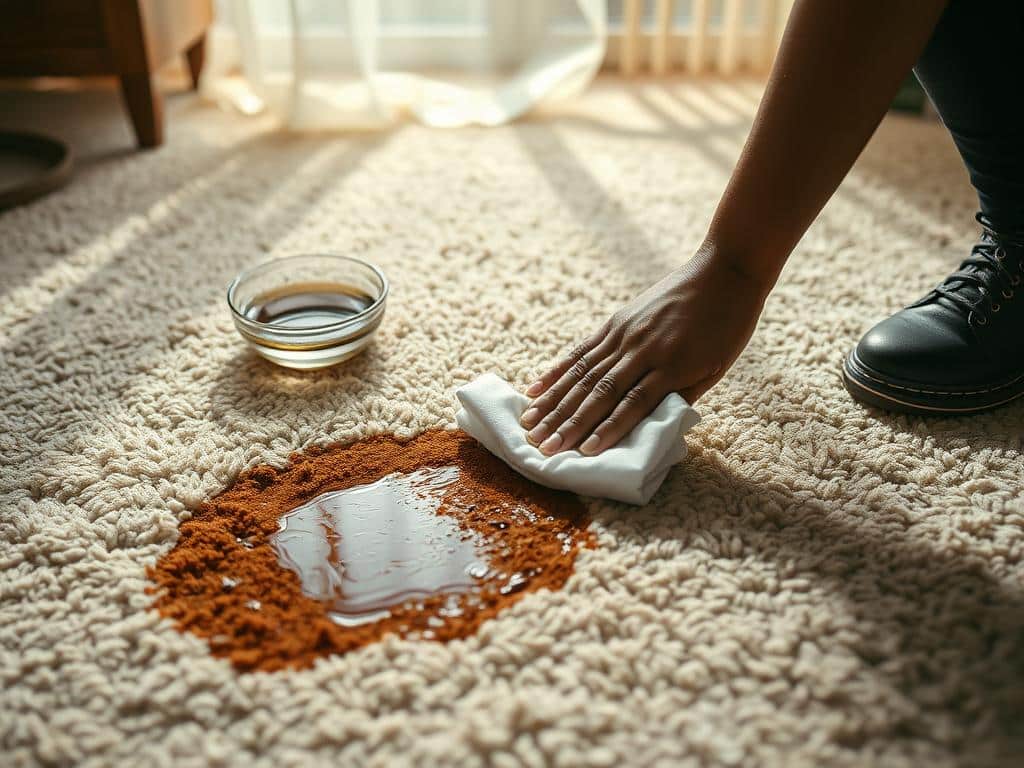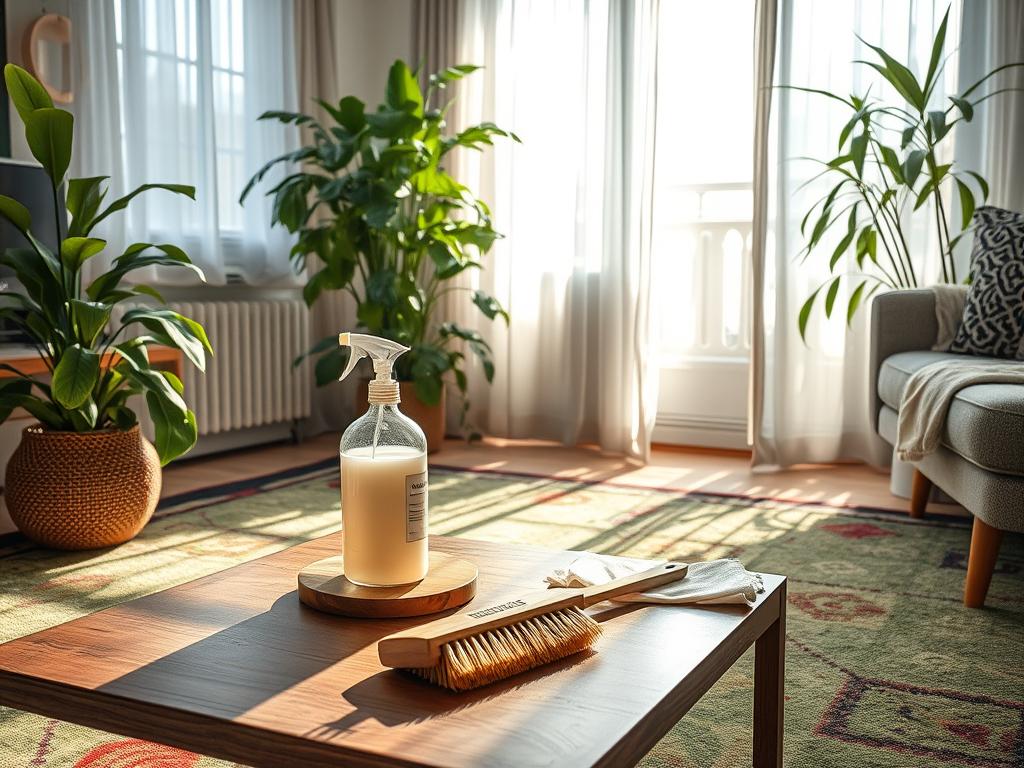
Keeping your upholstery clean is not only about looks. It also helps your furniture last longer. We’ve gathered top tips from our experience with many homes. These tips for upholstery maintenance and furniture care combine simple home remedies and new techniques. They help avoid stains and damage without leaving behind harmful residues.
Household products like Free & Clear Clorox2 Stain Remover work well for stain removal. Agents like ScotchGard are great for protection. Although professional cleaning is best for a deep clean, the right care methods keep upholstery looking new. Simple acts like vacuuming, using baby wipes for spills, and applying fabric protectors, make a big difference.
Knowing the cleaning codes of your furniture is essential. Always follow the manufacturer’s advice for the best care. When unsure, it’s wise to consult a professional cleaner to maintain your upholstery’s look and feel. Using everyday items like rubber gloves and fabric softeners is a smart, budget-friendly way to clean.
Understanding Upholstery Cleaning Codes
It’s vital to know how to care for your furniture to keep it looking great. Each cleaning code tells you how to do this best. By following these, your furniture will continue to look its best for years.
Code W: Water-based Cleaning
Code W means you can use water-based cleaners for these fabrics. It’s great for handling spills with a mild detergent or foam. This makes it easy to keep your furniture clean on your own.
Code S: Solvent-based Cleaning
For Code S fabrics, avoid water and use dry-cleaning solvents instead. This approach suits natural fabrics that can’t handle water. It’s usually safer to have these fabrics cleaned by experts to prevent damage.
Code W/S: Water- or Solvent-based Cleaning
This code lets you choose between water-based and solvent cleaners. It’s a flexible option that’s great for spot cleaning. Always test on a small area first to ensure the fabric can handle it.
Code X: Vacuum or Light Brushing Only
Code X is for fabrics that need gentle care. Just vacuum or use a soft brush on these. They can’t be cleaned with water or solvents without risking damage. For more tips, check out a detailed guide on cleaning techniques for different fabrics.
The Importance of Regular Vacuuming
Vacuuming your furniture regularly is key for its look and life span. You should do it at least once a week. This stops dirt from sticking to the fabric, which can cause damage over time. By removing dust and debris, your furniture stays clean and welcoming.

Prevents Dirt Penetration
Vacuuming often helps stop dirt from getting deep into your upholstery. This prevents fabric from getting ruined and colors from fading. Use the right vacuum attachments to clean every nook and cranny. Vacuums with HEPA filters can catch nearly all tiny particles, keeping your upholstery spotless.
Improves Appearance and Longevity
Regular vacuuming makes your furniture look better and last longer. Kathy Cohoon from Two Maids says cleaning often adds years to furniture life. Vacuuming often is important for pet owners. It reduces pet hair and dander, which helps with allergies and keeps furniture clean. Also, getting your furniture professionally cleaned once or twice a year will help keep it in top shape.
Tips for Effective Vacuuming
Here are some tips to vacuum more effectively:
- Use crevice tools for corners and edges that are hard to reach.
- Try dry brushing before vacuuming to loosen dirt.
- Be careful with delicate fabrics and adjust suction power accordingly.
- Use a dust brush attachment for leather furniture to avoid scratches.
These strategies help you get rid of dust well and take care of your furniture. Also, remember to maintain your vacuum regularly for its best performance. Check out this link for more on why simply vacuuming isn’t enough to keep your carpets clean: vacuum maintenance.
How to Remove Different Types of Stains
Understanding how to clean different stains off upholstery is key. This guide will help you tackle common stains. You’ll use home remedies and proper cleaning methods.
General Upholstery Stains
A club soda with mild detergent mix often does the trick for many stains. First, dab the stain with club soda. Then, put on a mixed detergent solution lightly. Always check your upholstery’s cleaning code first. Items with Code W work well with water-based cleaners.
Grease or Oil Stains
Grease or oil stains are tough but not unbeatable. Try covering the stain with cornstarch or baking soda for a few hours. Afterward, brush the powder off. You might also need a dot of dish soap. This tactic works well in most cases, based on user feedback.
Coffee Stains
For coffee stains, a paste of vinegar and baking soda helps. Spread it over the stain, and wait for 15 minutes. Then, dab with a wet cloth and rinse with cool water. This method is recommended by cleaning pros.
Crayon Stains
Crayon stains, with their waxy nature, need care. Start by scraping off the wax carefully. Then put some rubbing alcohol on a cloth and dab gently. Remember, don’t wet the fabric too much, especially if it needs solvent-based cleaners (Code S).
Blood Stains
Act fast with blood stains using cold water. Moisten a cloth in cold water and dab at the stain to stop it from setting. Or, make a paste with baking soda and water. Apply it to the stain for 30 minutes, then rinse. Many find this method highly effective.
Always check your furniture’s material and cleaning instructions before starting. For detailed advice on keeping your home clean, look at this daily cleaning routine.
Essential Upholstery Cleaning Tips
Keeping your upholstery in top shape makes it look new and last longer. Here are some key tips for easy and effective DIY care.
Using Hot Water and Stain Removers
Hot water works wonders on tough stains. Mixing it with diluted stain removers helps loosen dirt and relax fabric. Always test the stain remover in a hidden spot to avoid damage.
The Role of Cotton Rags
100% cotton white rags are perfect for picking up dirt and moisture. They’re soft yet strong, meaning they clean without harming the fabric.
Sparkling Water and Vinegar Solution
A mix of sparkling water and vinegar cleans upholstery naturally and effectively. Sparkling water lifts dirt, and vinegar cuts through grime and soap residue. It’s great for different kinds of fabrics.
Fabric Shavers for Lint and Pilling
Use a fabric shaver after cleaning to remove lint and pilling. This tool makes your furniture look newer and protects the fabric for the future.
Protecting with ScotchGard
ScotchGard adds a protective layer to clean upholstery, blocking spills and stains. It makes future cleaning easier, saving you time and preserving the furniture’s look.



